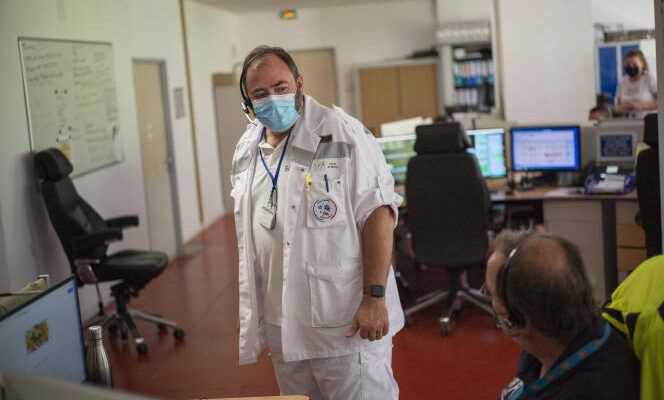“We do not realize, but it goes very quickly thirty seconds. ” Installed at one of the stations of the respondents to the emergency medical aid service (SAMU) of Moselle, in Metz, the medical regulation assistant Maxime Dufour has just finished with a lady “A little hard of the leaf”he said with a smile, after exceeding his target by a few units. “Hello health emergencies”, he continues by clicking on a new call.
Thirty seconds is the maximum time that the young man of 29 must respect to “Categorize the emergency”, that is to say “Sorting out vital urgency and relative urgency”, before transferring the call to one of the two channels in the room at the Metz center: emergency physicians and general practitioners. “At the beginning, it’s very stressful, but now it’s been several months that we operate like that, we are used to it”, he said.
Metz is one of the twenty-two pilot sites of the healthcare access service, the “SAS”, which have been tested in the region since January. With one objective: to bring together SAMU and city medicine, in order to better meet needs and avoid the saturation of emergency services.
In the city of Grand-Est, where general practitioners had already worked in close collaboration with the SAMU since 1992, the new tested system made it possible to move up a gear. With, first of all, the “dual level dropout”, introduced in November 2020, this initial sorting carried out by Maxime Dufour, on the front line, on Friday June 11, with a colleague.
“Boost”
In the young man’s back, the average waiting time of callers is displayed live. “17 seconds” at this midday hour, a good score. Several numbers lead to the reception center installed on the ground floor of the Mercy hospital, one of the sites of the Metz-Thionville regional hospital: 15, but also 112 (European emergency number ), or Medigarde, the line for general practitioner care (0 820 33 20 20).
“Three quarters of the time, things are clear”, resumes the regulation assistant, showing on his desk the list of “Vital distress”such as cardiac arrest or imminent childbirth, for which it can immediately trigger ” means “ (mobile emergency and resuscitation structure, ambulance, etc.). Sometimes unraveling the thread is more complex. “For chest or abdominal pain, it goes to the SAMU most of the time, but it can be an anxiety attack that can be treated from that side”, he explains, pointing to the offices of the general medicine pole, which some emergency physicians still call the “Bobology”. To determine the severity, Mr. Dufour must chain questions on “Irradiation of pain”, the ” difficulty breathing “ and the “Antecedents” of the person, he enumerates mechanically.
You have 52.19% of this article to read. The rest is for subscribers only.
